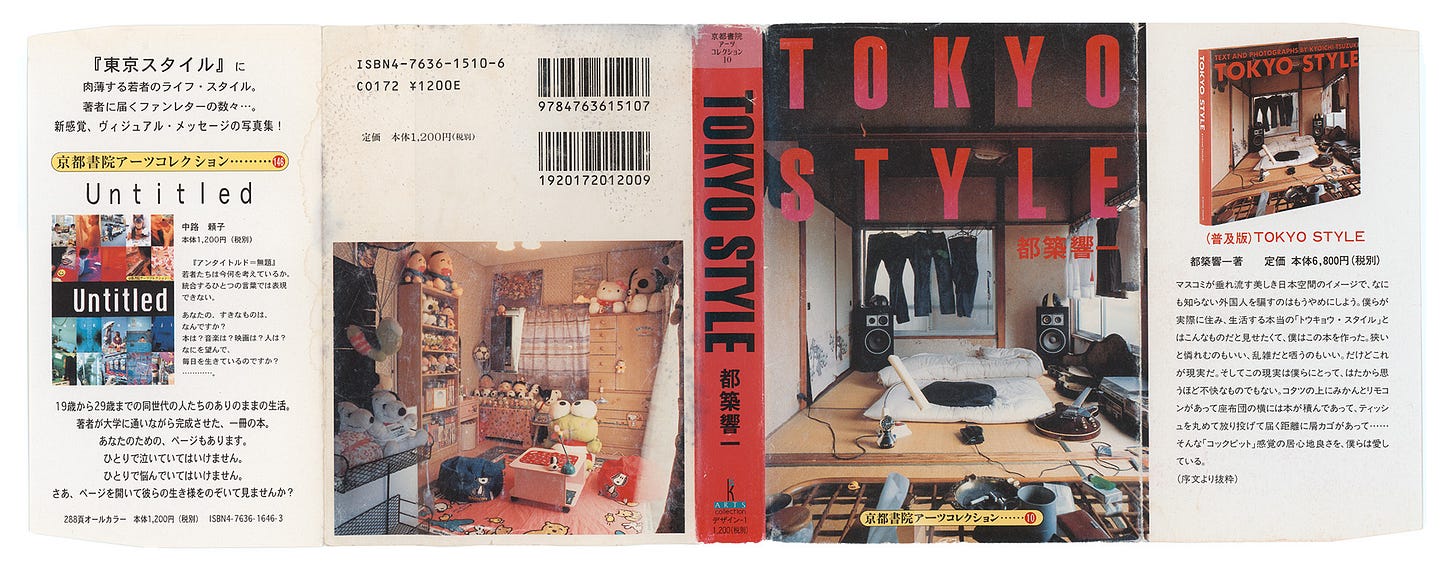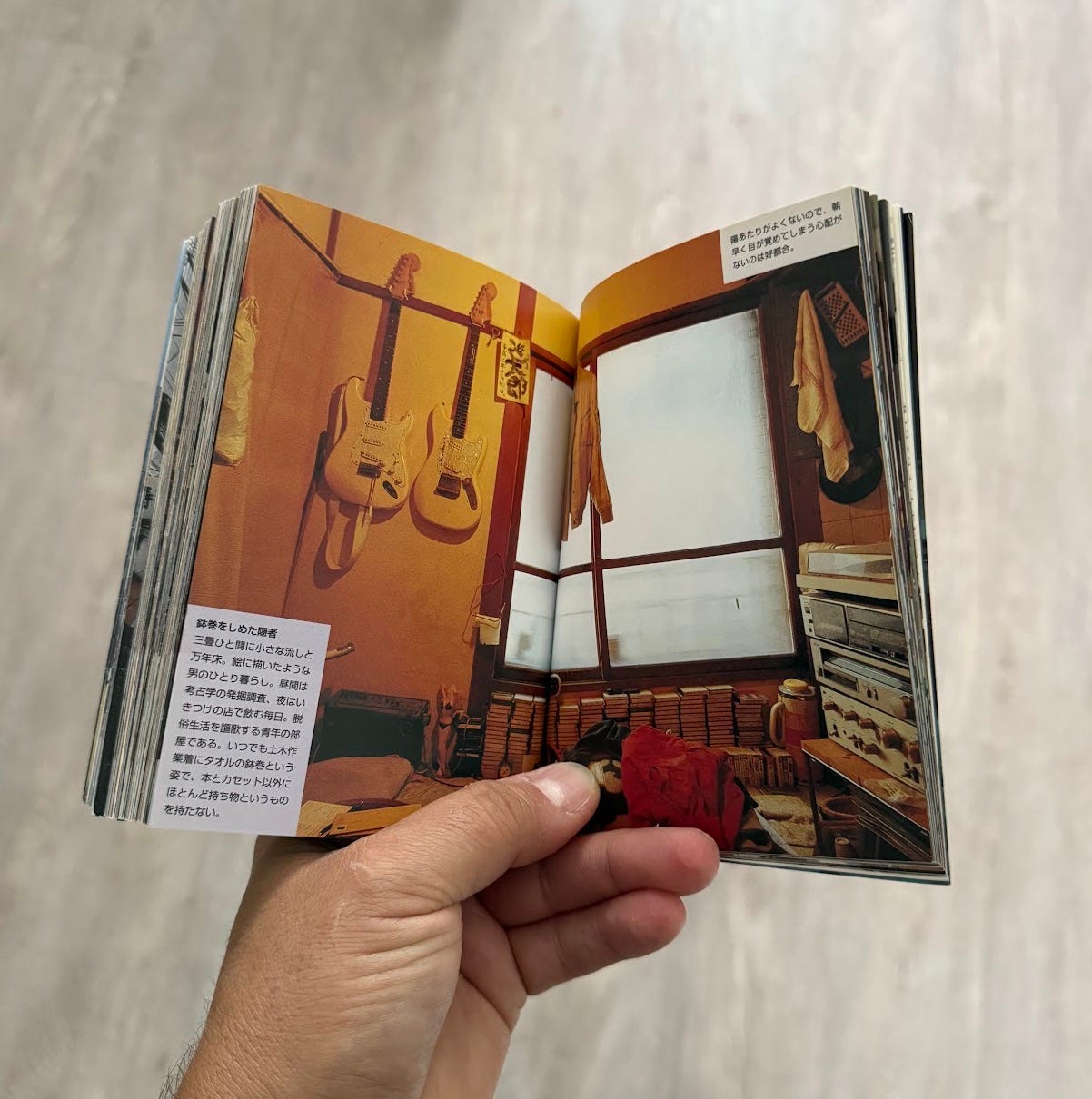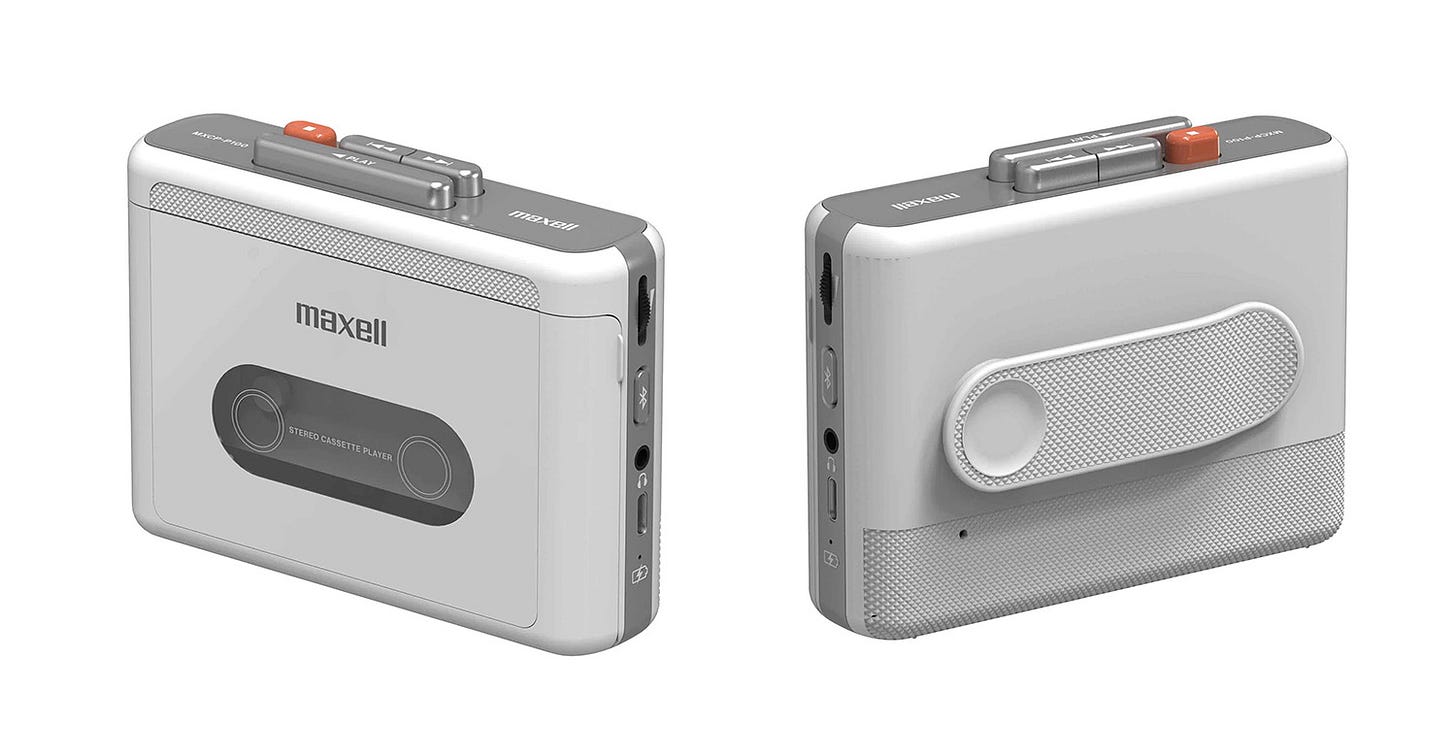Five Things 08
Mbappé's good looks, an old bunko photo book of Tokyo apartments, new portable cassette decks, and the skate doc to end all skate docs in Selectism for Thursday, July 3, 2025.
It’s been a while since I did a long stay overseas and had to pack for it. Long stay to me being more than 14 days, or the equivalent of when one must consider doing your laundry during said trip. Most Airbnb’s I’ve rented come with laundry, but it seem to be the one amenity I forget while packing my suitcase.
On-premise laundry is a game changer for long trips, and when considered top of mind, will keep me from packing what
’s boss calls “creep.”Take it from me, avoid packing creep. You know that pair of pants you decided to throw in at the end? Leave it at home. The extra jacket you want with you? One is enough. Consider versatility and bring at least 10% less than you think you'll need.
I may even stop here and argue that I would pack even less for a long haul than I would for a sub-14 days stay: At day 14 I’m out of clothes, but if staying long, why even bother with extras when you can do laundry.
That is of course, unless you outsource your laundry and have never bothered with it. You’re just going to pack whatever.
Anyways, more on packing, ESPN’s New York City skate doc, cassette decks and more this week in Selectism.
- Jeff
Kylian Mbappé for Dior
A guy I’m pretty sure never does his own laundry: footballer Kylian Mbappé (@k.mbappe), who’s having a surreal year, or at least I think he is.
To bring some up to speed: Mbappé was a lifer at PSG football club in Paris, where he and his team would score many big wins,but never the elusive Champions League crown. So off to Real Madrid he went in 2024, only to then watch his former PSG teammates win that very trophy this year.
But maybe none of this is on his mind. It’s summer, and he’s probably more annoyed about wasting June and July playing in the FIFA Club World Cup, a tournament seemingly hated by everyone. As The Athletic headline put Jamie Carragher’s quote: “‘No appetite’ for Club World Cup from players, clubs and supporters.”
One bright spot for Mbappé? His appearance in the highly anticipated campaign for Jonathan Anderson’s DIOR debut. A week earlier, Anderson teased his inspiration: two famous Warhol photographs of Lee Radziwill and Jean-Michel Basquiat, which you can feel in Mbappé’s sportswear look below.
I really like this campaign for giving us the off-field Mbappé I always imagined: composed, capable of pulling off a sports coat, but still tussling a bit with his tie knot. That vulnerability is human, but not something you usually get from a masculine figure in high fashion.
It all feels right somehow.
ESPN 30 for 30 “Empire Skate” Documentary
Monday saw the premiere of “Empire Skate,” a highly anticipated new documentary under ESPN’s 30 for 30 moniker. The film explores what is arguably the origination era of modern New York City skateboarding and the rise of Supreme, the skate shop and brand, as a monolith.
That story, as told in “Empire Skate,” focuses on a few distinct but wildly important shops, shop owners and local skaters who, over the course of about ten years, laid the foundation for modern street skating and Supreme’s meteoric rise.
What sets director Josh Swade’s film apart from any other tellings to date was his access to the people who were there, IRL, doing it. Maybe it was ESPN’s name that helped pull it all together, but being able to hear directly from original core skaters, team members, managers, and beyond on the subject of SHUT, SkateNYC, Zoo York, Supreme (to name a few) is extremely rare. We get all that New York skate history in a nice little package.
There are first-hand accounts that bring clarity to decades of Supreme folklore: stories of superiority, bias, and side-hustle handshakes that loomed over the brand. And much more.
“Empire Skate” is streaming now on ESPN+.
“Tokyo Style” book by Kyoichi Tsuzuki 1993
Everyone has a different way of organizing their bookshelves, but most fall into one or more of the following: alphabetically by author or title, by subject, by color, or by size. I prioritize by subject and size, and force all odd-sized outliers, like small books, into a stack rather than onto a shelf.
Stacks are annoying. They’re the worst way to store books because they make them hard to access, especially as they get larger. Some books, though, never fit on shelves and leave us no choice but to stack them.
Take these monsters from Rin Tanaka’s “My Freedamn!” series: the books are massive because they need to be. Tanaka and his gang of vintage gods showcase hundreds of items in large format allowing for details in the clothing and textiles to be studied. If they were smaller, they’d annoy me less—but they’d likely bring less joy too.
On the opposite end of the spectrum is a tiny book that I consider essential in understanding Tokyo culture and density, the photography book “Tokyo Style.” Released in 1993 as a hardcover, Tokyo Style documents the modest, often frenetic apartments of everyday Tokyo residents through the lens of photographer Kyoichi Tsuzuki, who himself did not believe was being properly represented in popular Western media, after Japan’s “bubble crisis” of the late 1980s.
An excerpt from Tsuzuki’s preface hit a particular mood. Here’s a rough translation I pulled from the inside cover:
Let’s stop deceiving clueless foreigners with the idealized image of Japan that the mass media keeps flooding the world with. I created this book because I wanted to show what the real Tokyo Style looks like—the one we actually live in day to day. You can pity it for being cramped, or criticize it for being messy. But this is reality. And for us, this reality isn’t as uncomfortable as it might seem from the outside.
That’s heavy stuff, but it plays on the heartstrings of my ’90s shelf, even if I didn’t read the preface until today.
For me, the book marked the beginning of my obsession with Japan and Japanese culture. In 1994, I was at Northeastern University in Boston. One of my classmates, a born-and-raised Tokyo guy who was on the pulse of everything cool, especially music, gifted me a copy of his “bunko” book on Japanese apartments.
And that was it. I spent hours gazing into the small pages of “Tokyo Style,” trying to make out objects like hi-fi systems, guitars, sneakers, figuring out what records were scattered across the floors. It was mesmerizing.
It was my first look inside a real Tokyo apartment: cramped but somehow neatly organized, with stacks of vinyl, guitars, and speakers existing just millimeters from the tatami mattress.
I recently rediscovered the book during a renovation. I started recalling others I’d talked to about the book over the years and reached out to the great archivist Charlie Morgan for his take on its importance.
It’s a gem of a book, that one. I think I got it for literally a pound at a student fair around 2000.
It’s one of those books you can just look at for hours and pick little things out. I think because it’s so small, too—it takes effort to find things in the photos.
I just remember it being full! There’s one page with a home office, model kits, consoles, hi-fi stuff which I’m sure you appreciate. Guitars! Loads of amazing guitars.
The fullness that Charlie and I see in those photos is something to marvel at, again and again.
“Tokyo Style” was reissued in 2024 by the excellent Apartamento imprint in its original larger hardcover format, though it appears to be sold out.
You can still grab the original small-format Japanese bunko edition, like the one shown above, for about $22 on Amazon or eBay. I highly recommend adding it to your library.
Maxell Japan MXCP-P100 Cassette Tape Player
If you know me, you know I love the idea of cassette tapes coming back. Same goes for compact discs, MiniDiscs, or any physical format of music. I love their return or rather, their reappreciation, because it reminds people my age of a time when music felt more personal and intimate.
Compiling a mixtape or CD for a friend or love interest took time. You had to play a song all the way through unless your deck let you dub at 2x speed, which helped a bit, but not by much.
That physical connection to a tape or CD changed when portables like the iPod came out, ushering in a whole new era of music.
But mixtapes remain. And like a lot of people, you probably still have one or two lying around from your youth. I recently found not a mixtape, but one of my earliest moments on microphone.
It’s 1992 and I made a run from Hartford, CT to Foxboro, MA to see U2’s ZOO TV Outside Broadcast Tour, with friends from high school. It’s teenage driving banter at best, at worst a memory of how annoying I was in my teens. This tape is worthless to anyone except the people in that Volvo station wagon on that midweek afternoon and evening.
And while many still hold onto the mixtapes they love, most no longer have a cassette player to hear them on. Unsurprisingly, I have plenty of tape decks and know how to fix them to work like new. But nobody else wants to deal with that hassle, and almost without exception, if you buy a vintage tape deck today, it’ll need service (read: new belts), unless it’s already been refurbished.
And that sucks. It’s a lot of work just to hear the one mixtape you didn’t toss. On top of that, many people don’t like buying used or vintage gear. They want new.
That’s where companies like Maxell Japan come in. The Japanese electronics maker, who, alongside TDK, ruled the high-bias blank tape world in the ’90s, is filling a void that only a small handful of other companies are filling.
The Japan-exclusive Maxell MXCP-P100 cassette player is a $90 solution. At that price, I’m not expecting audiophile components, but for simple playback and the joy those memories bring? It’s a solid pickup.
The MXCP-P100 is dead simple: a few play and rewind buttons, a headphone jack, and Bluetooth connectivity make it easy to connect across your devices.
Buy one takes a little digging. While you can buy direct from Amazon Japan from almost anywhere, eBay has plenty reselling for about $140 at the time of writing.
How Many Speakers are Too Many?
A not-so-serious poll question today; one born from the eternal struggle between space, aesthetics, and sound. Above, three different floor standing speakers:
A black pair of JBL L5s from the mid-’90s. They’re a little beat up, missing top grills, but still handsome in that tall, narrow, black-tower kind of way. And more importantly, they sound phenomenal. Like better than phenomenal. They sound and perform the way I like my music: in your face, strong bass and clear stabbing highs. But they look a bit basic, no?
A pair of 1980s Vandersteen Model One, wrapped head-to-toe in that iconic mesh sock. Underneath, they share a similar top silhouette with the JBLs. Also made in the USA, and also very much their own thing visually and sonically. These are the speakers I use when waking up on a Sunday morning listening to direct and clear music, where bottom end of is no bother. Vandersteen fit well within a mid century modern interiors, making them strong choice for those in love with woods.
And in the back, nearly disappearing into the room: a pair of 2022 Monitor Audio Silver 500 7G in full matte white finish, including the drivers. A gift to myself when I came to Miami. Minimalist. Practically sculpture. They are extremely clear and neutral and are my reference speakers.
Let’s get this out of the way: all three sound incredible in their own unique ways, each pairing well with specific genres and late-night, slightly off-the-wall listening sessions often under the influence (it’s a COVID habit I have yet to kick).
But space is a premium, and I have to choose just one. So, which of these three do you find the most attractive and best looking?
Vote below. See you next week. Happy Fourth to those celebrating.

















